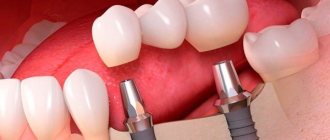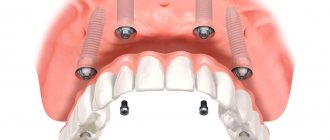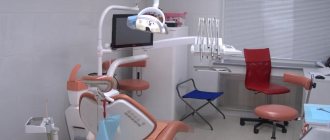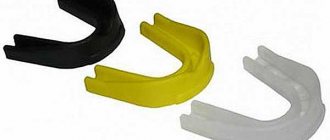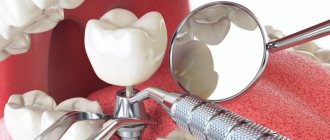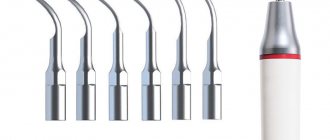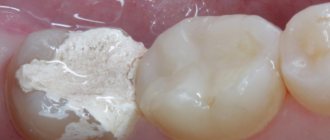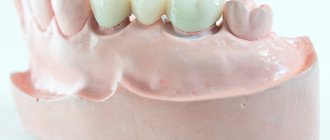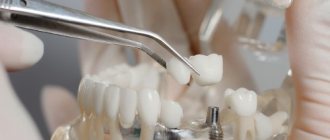Dental prosthetics is a responsible process, the success of which depends on both the patient and the attending physician. It is necessary to correctly select the optimal method of prosthetics and select the most suitable materials for the manufacture of false teeth. The doctor must correctly carry out the procedure for installing the prosthesis, and the patient must carefully monitor its integrity and condition in the future.
But at the stage of choosing a method of prosthetics, a person is concerned not only with the advantages and disadvantages of certain dental services, but also with their cost, since the prices for some prostheses are too high. Therefore, when seeking medical help, it is advisable to know how much it costs to insert one tooth.
How much does it cost to insert a front tooth?
When making prosthetics for incisors and canines located in the smile line, you should choose those prostheses that differ least from neighboring healthy teeth in color and light reflectivity. Most often, prosthetists advise installing the following structures:
Metal-ceramic crown on an implant. This design is the highest quality and most reliable. But after its installation, a visual defect may appear: a part of the implant embedded in the gum may be visible. Prices for implants start from approximately 15 thousand rubles. and may vary depending on the type of metal used.- Ceramic crown on an implant. It looks better, but also costs more - from about 25,000 rubles per unit.
Compulsory health insurance program for citizens in Russia
Compulsory medical insurance guarantees free care in public clinics and hospitals. Medical insurance comes with territorial and basic programs. Basic policies apply to the entire territory of the Russian Federation. Territorial - only for the territory of a specific region. Such an insurance document determines the procedure for receiving free assistance to insured persons in a certain region of Russia.
Each region, region of the country has its own territorial compulsory insurance program. It is approved at a meeting of self-government bodies. The program is formed taking into account all the requirements recommended by the Ministry of Health. Provision of free services is possible only at the place of registration.
Dental services are also included in the compulsory medical insurance policy. Therefore, free dental care is available to every citizen. To get help, you need to go to a dental clinic or hospital. Have your insurance policy and identification document with you. At the reception, the patient fills out an application for choosing a medical organization and creates a medical record, which will contain all the information about the treatment. Afterwards, the patient is referred to a specialist for examination and further treatment.
Treatment covered by insurance is provided by some private clinics. To receive free help in a commercial clinic, a referral from a public clinic at your place of residence is required.
Patients are admitted and treated by appointment. It is impossible to get a scheduled appointment right away; you will have to wait about a week.
Without registration, appointment, queue and insurance, they accept patients in critical condition, with acute toothache, bleeding, high body temperature.
How much does it cost to get a crown on a tooth?
Any method of prosthetics includes the installation of crowns, which are paid separately. If the condition of the prosthetic tooth is satisfactory, you can only put an artificial crown on it. False teeth also vary in quality and price.
| Crown type | Properties | Manufacturing Features | How much does it cost to insert a crown on a tooth (minimum price in rubles in Moscow) |
| Metal-ceramic crowns. | For most patients, metal ceramics is the “golden mean” in terms of price and quality. This method of prosthetics is suitable for restoring front teeth, but has one significant drawback: the upper part of the artificial crown can give a “blue” appearance to the gums. | Foundry with cobalt-chrome alloy. | 6000 (may be lower when using domestic materials). |
| Frame production by milling. | 11000. | ||
| Using gold-platinum alloy. | 17000. | ||
| Ceramic crowns. | High-quality, beautiful, expensive designs. Some types of ceramic crowns can be fragile. | Made from porcelain. | 11000. |
| Made from zirconium dioxide. | 16,000 (from 8,000 – cheap, but low-quality analogues). | ||
| Metal crowns. | Unaesthetic, but very reliable prostheses. Suitable for restoring chewing teeth. In the area of the front teeth, such crowns are rarely installed. | Cast, cobalt-chrome. | 3500. |
| Gold. | 15000. |
Before installing a crown on a natural tooth, it is ground down. When the tooth is ground down, the patient is given a temporary plastic crown and only after some time is given the ordered one. Because of this, the cost of prosthetics for each tooth can increase by approximately 1–1.5 thousand rubles.
Why can't we leave everything as it is?
When a person loses a tooth in the smile area, he usually tries to restore it - but with chewing teeth that are not visible, the situation is different. Many people think that if one chewing tooth is lost, then nothing bad has happened - the rest are in place, which means they can chew.
Each tooth in our jaw carries an important functional, and not just aesthetic, load. If the tooth is not restored, negative consequences will inevitably occur:
- improper distribution of the chewing load will lead to gradual destruction of the teeth next to the defect - after all, they will have to work for themselves and for the lost tooth;
- bone tissue atrophy will occur due to the fact that there is no load during chewing;
- Bite defects will appear - if a tooth has been missing for years, then its row neighbors gradually begin to shift towards the empty space;
- chewing food will not be of sufficient quality, which over the years will lead to the development of problems with the gastrointestinal tract;
- bite defects will negatively affect the functioning of the temporomandibular joint, which will provoke neck pain, headaches, discomfort and pain when opening the mouth or chewing, even insomnia;
- Diction problems will appear.
Cost of bridges
Prosthetics can be performed using bridge structures that affect several teeth. At the edges they are attached to natural teeth or dentures; in the middle there are artificial crowns, which can be in tight or loose contact with the gums in the interdental space.
In modern dentistry, the following types of bridges can be made:
Adhesive bridge prosthesis. The cheapest method of prosthetics, in which the dentist makes a structure directly in the patient’s mouth, applying a composite material fixed with fiberglass thread or wire. Fixation with fiberglass and dental glue is not used when restoring chewing teeth, as it is fragile. Such prosthetics can cost 8 thousand rubles.- Metal-ceramic cast bridge made of cobalt-chrome alloy. Can cost from 18 thousand rubles.
- Ceramic bridge prosthesis. Such structures are made only from zirconium dioxide; porcelain is not suitable for these purposes. Such bridges are not installed on chewing teeth, since they are inferior to metal-ceramics in strength and durability, although they look more natural. Prosthetics with ceramics will cost at least 50 thousand rubles.
A plastic bridge can be installed as a temporary prosthesis. It is short-lived, but suitable for people with allergic reactions to other materials. Each plastic crown installed on one tooth costs from 1 thousand rubles.
Write a comment
Milan
December 20, 2015 at 10:52 pm
I first learned about plastic dentures on this site. I don't know what they really look like, but in the photo they look quite normal. Of course, metal ceramics are the most common, but in terms of beauty and aesthetic appearance, naturally, porcelain is the best known. Zirconium dioxide is also new, but it looks very realistic in the picture presented.
Elena
January 25, 2016 at 11:47 pm
Yes, getting sick is very expensive these days. It is necessary to treat teeth only at the stage of a problem, such as caries, for example. If you don’t cure a small black spot in time and don’t put a filling on one tooth, then over time you will have to treat two. and this is still good if you simply treat it, but when you already need to remove the tooth, it’s already completely sad. Personally, I go to the dentist every six months, it’s better to undergo prevention than treatment
Zhanna
November 25, 2016 at 6:36 pm
Well, yes, of course, prevention. My teeth didn't hurt at all. And one day, closer to autumn, I went to work in the morning during the summer, and returned home in the evening during the cold autumn. Lightly dressed, she was frozen to the bone. My throat hurt so much that it even began to swell. After three days of severe ear pain, an ambulance was called. An x-ray was taken at the hospital. Result: two teeth were pulled out. The third was treated. Then he had to be removed too. And the question of prosthetics arose. Now I will know what it costs and what is best to install.
Tatiana
February 7, 2022 at 6:54 am
I learned a lot from the information presented. At the moment, the question of choosing a dental implant has arisen, since I recently lost my front tooth. Prices, of course, are steep, but what can you do, going without a tooth is not an option, but now I know more, and I will build on the information I read on the site. You will also need to consult with your doctor which material is best to choose.
Kirill
October 4, 2022 at 10:32 am
My wife had a piece of her front tooth fall off, she went to the central dentistry, and they told her that she needed to get a crown. And then a friend advised her to go to a private one, and so, they said there were no problems and installed veneers. It turned out inexpensively - about 5 thousand for everything. Done in 1 session.
Anna
October 5, 2022 at 6:22 am
I am 56 years old, I wear a removable denture, it rubs all the time, and I have a lot of problems with care. My daughter promised to pay for permanent prosthetics for the entire jaw, so I’m preparing for treatment. What is better to choose, to use several existing teeth for fastening or to remove them and make a prosthesis for the entire jaw on implants? Why I doubt it, these teeth are already worn out and I’m afraid if I leave them, the work will quickly become unusable.
Ulyana
October 8, 2022 at 11:51 pm
I want to put a stump inlay so as not to make an implant; I have a root left from the third tooth on the upper right. The doctor said you can either remove it and do an implantation, or put metal-ceramics on the stump inlay. I don't know which is better. Of course, a crown will be cheaper in price, and there will be less pain, as I understand it, but I’m very afraid of dentists, but what if it doesn’t last long and in a couple of years I’ll have to get an implant? Please advise anyone who has experienced this type of treatment.
Prices for partial dentures
The absence of several units in the dentition can be compensated for by removable dentures , among which the most famous are the following:
Acrylic, nylon and polypropylene plate prostheses. They have approximately the same quality, but acrylic is harder. Not the most comfortable and reliable designs, but their prices suit many patients - a prosthesis for one jaw costs from 14 thousand rubles. If you need to replace a small number of teeth, the price may be slightly lower.- Clasp dentures. Higher quality structures that are fixed in different ways in the oral cavity, which leads to a wide variety of prices - from approximately 20 to 90 thousand rubles.
- Immediate dentures. If one or two front or back teeth are temporarily missing, the dentist can install a butterfly denture. It is short-lived, but lasts long enough to last until a permanent dental implant is inserted. The cost is varied: cheap ones - from 3 thousand rubles, higher quality ones - from 12 thousand rubles.
Clasp dentures are an expensive pleasure, especially if you choose the highest quality materials and fasteners. With sufficient financial resources and in the absence of contraindications, preference is often given to this method of prosthetics.
What teeth to put in if the jaw is completely “empty”?
Unfortunately, it also happens that a person is left completely without teeth on one of the jaws, and sometimes on both at once. What should he do in this case? Of course, you can just come to the dental clinic and ask: “I want to insert teeth - which ones are better? Tell". But it is advisable to understand at least a little about the issue of prosthetics in order to make the best choice. What does dentistry offer for complete edentia? Here are the main ways to restore teeth in this case:
- Complete removable dentures.
Very easy to install structures, which are artificial gums (base) made of acrylic or nylon with crowns fixed on it.When a patient decides to install complete removable dentures, which is better to choose - acrylic or nylon? There is no clear answer here; you need to look at the specific clinical situation and the wishes of the patient himself. In some cases, nylon is preferable, since it looks much better, is more comfortable to wear and can be installed by people in extreme professions (acrylic will not suit them, because due to its rigidity it can cause injury in the process of a fall or other unforeseen event). But sometimes it’s better to go with acrylic, which is stronger and better withstands chewing loads. When choosing removable dentures for teeth (which is better), you should ask your dentist - he will give individual recommendations.
- Prosthetics on implants.
There are several options for such dental restoration: bridge structures on implants (in case of complete edentia, they are installed in “sections”: several dentures on one jaw), removable dentures on implants (this method is especially recommended for the lower jaw, on which the usual removable structure does not hold very securely) and even clasp ones. Implantation serves as a support for the main prosthesis and makes it more reliable. If the patient is not afraid of serious stress on the body and is ready to invest a lot of money in restoring the health of his oral cavity, he can carry out a complete implantation of the entire dentition; modern technologies allow this possibility. - All-on-4.
A modern and very reliable method of restoring teeth, which is much more economical than full implantation. The essence of the method is that four implants are implanted into the jaw, on which the main structure is then installed, restoring the entire dentition.
Dental surgeon, implantologist at the 32 Dent clinic Sergey Leonidovich Yakubovsky: “We recommend All-on-4 prosthetics to patients with complete edentia as a gentle and very reliable way to regain their teeth. Full implantation is quite a serious burden on both the body and the patient’s wallet. And here there is an opportunity to restore the dentition at an affordable price, for a long time and with good aesthetics.”
Which teeth are better to insert: prices for prosthetics
Complete removable structures will cost 15-55 thousand rubles. If you plan to install them on implants, the cost of implantation will be added here, so the price will be higher - from 58 to 80 thousand rubles. All-on-4 prosthetics will cost approximately 50-60 thousand rubles (depending on the chosen main prosthetic design and types of implants).
Which dentures are best to install?
? It is advisable to at least have a rough idea of what you want when going to the dentist. And the doctor will help you navigate and choose the optimal method for a particular case, tell you about all the pros and cons of the chosen method and carry out proper installation. The main thing is to choose a good doctor!
The cost of restoring teeth with inlays and veneers
If the tooth is not completely destroyed, but the filling cannot restore its appearance and function, you can make an inlay from metal or ceramic.
| Type of tab | How much does it cost to insert an inlay into one tooth (thousand rubles) |
| Made from pressed porcelain mass | From 11 |
| Cobalt-chromium | From 3.5 |
| From zirconium dioxide | From 14 |
| Golden | Depends on current gold prices and the weight of the tab |
Small defects can be corrected with the help of overlays on the front tooth surface - veneers. Such plates are suitable for improving the appearance of the front teeth, as they are not too durable, but very aesthetic.
Ordinary veneers cost from 20 thousand rubles. While their improved, thinner and more beautiful analogues - lumineers - can cost twice as much. If the pads deteriorate, they are not replaced. In this case, there is only one thing you can do - install a crown.
Dental tab
Veneer
Indications for removal along with the root
No dentist will remove a tooth just like that, since each one is important for the normal functioning of the dental system - doctors still try to preserve them. To do this, fillings or restorative inlays, crowns, pins and stump inlays are placed in the root canals. So is it necessary to remove tooth roots before getting dentures? Yes, indeed, sometimes situations arise that removal is the only option, otherwise complications are possible - up to infection of the jaw bone or loss of all units in a row.
Let's consider cases when deletion is indispensable:
- the presence of vertical cracks in the roots,
- irreparable perforations in the root wall or in the bifurcation area (the place where the roots begin to branch under the crown),
- presence of a piece of dental instrument in the root canal that cannot be removed,
- chipping of the crown deep under the gum: in this case, placing a filling or core inlay may be problematic due to the damp environment around - such a restoration will not last long,
- the presence of neoplasms under the roots (cysts, granulomas) that cannot be eliminated without removal,
- destruction or complete dislocation due to injury: blow, bruise, gnawing something hard,
- inability to go through root canals with an instrument due to their non-standard shape,
- osteomyelitis of the jaw: if osteotomy (cutting off) of pathological areas of the bone is required,
- severe loss of bone and gums against the background of the late stages of periodontitis and periodontal disease: here the teeth become very mobile, and tartar builds up along the roots - an infectious focus arises, which leads to inflammation and toxic damage to the surrounding tissues (gums and jaw bone).
What determines the cost of prosthetics?
Prices for installing dentures and artificial crowns depend not only on the cost of the structures, but also on the following indicators:
- Type of medical institution – public or private.
- The level of material equipment in dentistry and the availability of experienced, highly qualified personnel.
- The type of material used to make an implant or crown.
- Manufacturer of the product or material for its manufacture - domestic or foreign.
- Additional costs due to the need for preliminary treatment of oral diseases.
- The cost of the dentist and dental technician to prepare, manufacture and install a crown, implant or bridge.
Prices for crowns, implants, bridges and other types of prostheses can vary greatly in different clinics. You can only find out how much it costs to insert one tooth from your attending physician. Since the websites of dental clinics most often indicate price ranges or their minimum values.
Surgical stage
Purpose: preparation of the site for implant installation, implantation of an artificial root, formation of the correct gum contour.
Under local anesthesia, the implantologist sequentially performs the following 4 surgical procedures:
Dissection of gum tissue
To gain access to the bone of the lower or upper jaw, the doctor makes a small incision in the gum and removes the flaps.
Formation of a landing channel for an implant
Using a surgical template, the doctor drills a channel of the required depth and width into the spongy tissue.
The doctor measures the resulting depth of the canal in the bone tissue and compares it with the required value.
Performs smooth boring of the channel to the planned width. Drills of different diameters are used sequentially.
Fixation of titanium rod
An implant is placed in the hole.
First, the artificial root is implanted using an electrical device. It is then screwed in by hand until it matches the edge of the bone.
The implant is closed with a temporary plug.
Gum suturing
The edges of the incisions are sutured to close the plug.
After the implant has healed (3-4 months on the lower jaw and 4-6 months on the upper jaw), to give the gum an aesthetic contour, the plug is removed and a gum former is placed.
A maximum of 14 days after installation of the gum former, it is replaced with an abutment - the connecting link between the implant and the orthopedic structure.
A temporary coping is placed on the abutment for taking impressions.
Who can use the quota
Who is entitled to a quota for dental prosthetics? It can be received by socially vulnerable segments of the population - pensioners, disabled people, disabled children, people with severe pathologies. The list should also be supplemented by pensioners of the Ministry of Internal Affairs and those who retired from military service, heroes of the Second World War, home front workers, Heroes and Veterans of Labor, Heroes of the USSR and the Russian Federation, mothers of many children, etc.
You need to know that there are several programs for free dental prosthetics - federal and regional. The federal list includes only those pensioners who retired from government, military service and the Ministry of Internal Affairs. Regions or subjects of the Russian Federation supplement this list with other categories of citizens. You can use the quota for free prosthetics once every 5 years.
